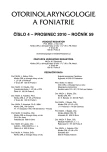Evaluating the Quality of the Glottis Closure
Authors:
J. Pešta 1; J. Slípka 1; P. Nový 2; F. Vávra 3
Authors‘ workplace:
Klinika ORL FN Plzeň
; přednosta kliniky doc. MUDr. J. Slípka, CSc.
Katedra informatiky a výpočetní techniky, Fakulta aplikovaných věd ZČU, Plzeň
1; vedoucí katedry prof. Ing. J. Šafařík, CSc.
Katedra matematiky, Fakulta aplikovaných věd ZČU, Plzeň
2; vedoucí katedry prof. RNDr. P. Drábek, DrSc.
3
Published in:
Otorinolaryngol Foniatr, 59, 2010, No. 4, pp. 190-196.
Category:
Original Article
Overview
The aim of this work is to present new knowledge, which is useful for evaluating the quality of the glottis closure. The source of knowledge is the analysis of one period of the laryngeal tone record, which is obtained by measuring the changes of sound pressure, through the microphone placed in front of the patient’s mouth. The principle of the method is the Fourier analysis of this period to detect the transition process as a response to pressure pulse. Which process is caused through closure of glottis. For the evaluation the quality of the glottis closure is used the regression SCORE model. The variables in the model are standardized amplitudes, which are calculated from the coefficients of Fourier series. The parameters of SCORE model are the coefficients, which are derived comparisons with the expert rating of individual records. The expert rating reflects the results of medical examination methods of quality analysis of voice and experience of expert, too. Used examination methods and new knowledge expressed SCORE value, can be used for evaluating the vocal cord function and determination of the diagnosis of voice disorders. That method measures only the quality of the closure of the glottis and does not cause and ignores the differences in the strength of phonation.
Key words:
vocal fold, glottis, transition process, regression analysis, score model, Fourier analysis.
Sources
1. Hátle, J., Likeš, J.: Základy počtu pravděpodobnosti a matematické statistiky. SNTL Praha, 1974.
2. Rényi, A.: Teorie pravděpodobnosti. Academia Praha, 1972.
3. Rao, C. R.: Lineární metody statistické indukce a jejich aplikace. Academia Praha, 1978.
4. Kufner, A., Kadlec, J.: Fourierovy řady. Academia Praha, 1969.
5. Zhang, D., Lu, G.: A comparative study of Fourier descriptors for shape representation and retrieval. The 5th Asian Conference on Computer Vision, Melbourne, Australia, 2002.
6. Švec, G. J.: Fyziologická akustika zpěvního hlasu: Nový pohled na starý problém. 60. akustický seminář & 36. akustická konference, Kouty, 2000, edited by O. Jiříček. Praha, ČVUT & Česká akustická společnost, ISBN 80-01-02179-3.
7. Švec, J.: Studium mechanicko-akustických vlastností zdroje lidského hlasu. Dizertační práce, Přírodovědecká fakulta, Univerzita Palackého v Olomouci, Olomouc, 1996.
8. Novák, A.: Foniatrie a pedaudiologie II. UNITISK, spol. s r.o., Praha, 1996.
9. Kubík, S., Kotek, Z., Strejc, V., Štecha, J.: Teorie automatického řízení I., Lineární a nelineární systémy. TKI-SNTL, Praha, 1982.
Labels
Audiology Paediatric ENT ENT (Otorhinolaryngology)Article was published in
Otorhinolaryngology and Phoniatrics

2010 Issue 4
Most read in this issue
- PFAPA Syndrome in Child ENT Area and Its Indication for Tonsillectomy
- Kawasaki Syndrome – Possible Cause of Cervical Lymphadenitis in Children
- Vestibular Evoked Myogenic Potentials – VEMP: Method Standardization
-
Obstructive Sleep Apnea – the Importance of Septoplasty and Turbinoplasty
Part II (Practical)
